Munson B.R. Fundamentals of Fluid Mechanics
Подождите немного. Документ загружается.

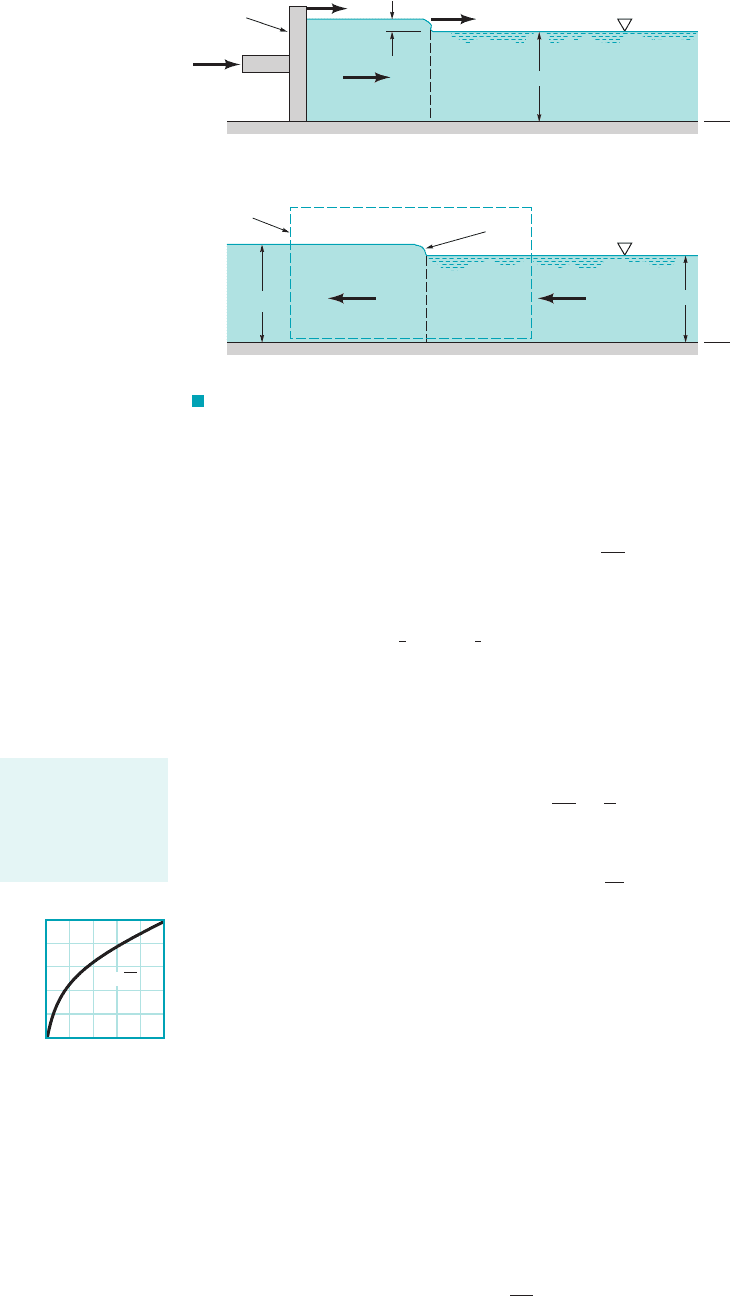
or in the limit of small amplitude waves with
(10.1)
Similarly, the momentum equation 1Eq. 5.222is
where we have written the mass flowrate as and have assumed that the pressure variation
is hydrostatic within the fluid. That is, the pressure forces on the channel cross sections 112and 122
are and respectively. If we again impose the
assumption of small amplitude waves [i.e., ], the momentum equation reduces to
(10.2)
Combination of Eqs. 10.1 and 10.2 gives the wave speed
(10.3)
as indicated by the figure in the margin.
The speed of a small amplitude solitary wave as is indicated in Fig. 10.2 is proportional to
the square root of the fluid depth, y, and independent of the wave amplitude, The fluid density
is not an important parameter, although the acceleration of gravity is. This is a result of the fact
that such wave motion is a balance between inertial effects 1proportional to 2and weight or
hydrostatic pressure effects 1proportional to 2. A ratio of these forces eliminates the common
factor but retains g. For very small waves (like those produced by insects on water as shown in
the photograph on the cover of the book), Eq. 10.3 is not valid because the effects of surface tension
are significant.
The wave speed can also be calculated by using the energy and continuity equations rather
than the momentum and continuity equations as is done above. A simple wave on the surface is
shown in Fig. 10.3. As seen by an observer moving with the wave speed, c, the flow is steady.
Since the pressure is constant at any point on the free surface, the Bernoulli equation for this
frictionless flow is simply
V
2
2g
y constant
r
g rg
r
dy.
c 1gy
dV
dy
g
c
1dy2
2
y dy
F
2
gy
c2
A
2
gy
2
b
2,F
1
gy
c1
A
1
g1y dy2
2
b
2
m
#
rbcy
1
2
gy
2
b
1
2
g1y dy2
2
b rbcy31c dV2 c4
c y
dV
dy
dy y
10.2 Surface Waves 537
Control
surface Stationary wave
V = (– c + V)i
δ
y + y
δ
y
V
= – c i
x
x
Channel width = b
(1) (2)
(
b)
(
a)
Moving
end wall
V
δ
y
δ
V
δ
c = wave speed
y
Stationary
fluid
^
^
F I G U R E 10.2 (a) Production of a single elementary wave in
a channel as seen by a stationary observer. (b) Wave as seen by an observer
moving with a speed equal to the wave speed.
The wave speed can
be obtained from
the continuity and
momentum equa-
tions.
10
8
6
4
2
0
0246810
c, m/s
y, m
√
c = gy
JWCL068_ch10_534-578.qxd 9/23/08 11:51 AM Page 537
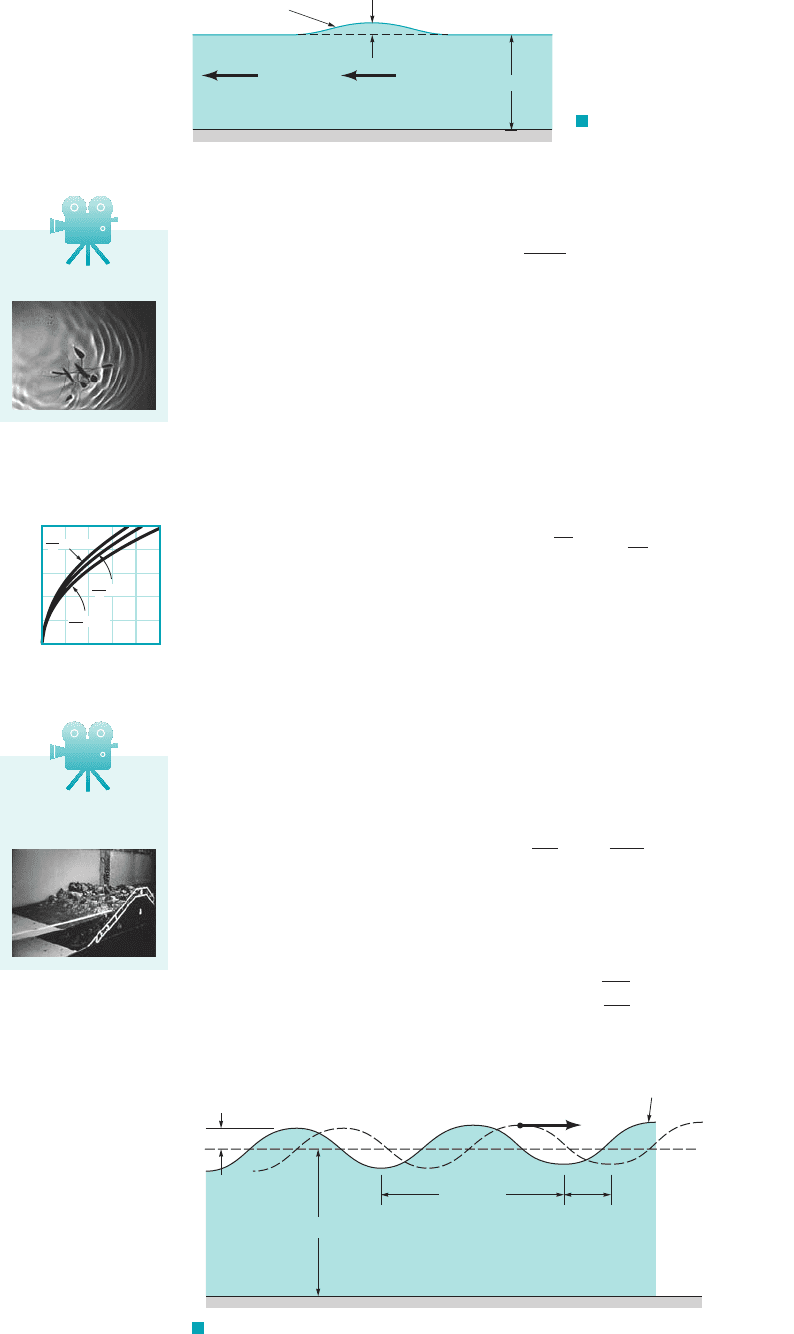
or by differentiating
Also, by differentiating the continuity equation, we obtain
We combine these two equations to eliminate and and use the fact that for this situation
1the observer moves with speed c2to obtain the wave speed given by Eq. 10.3.
The above results are restricted to waves of small amplitude because we have assumed one-
dimensional flow. That is, More advanced analysis and experiments show that the wave
speed for finite-sized solitary waves exceeds that given by Eq. 10.3. To a first approximation, one
obtains 1Ref. 42
As indicated by the figure in the margin, the larger the amplitude, the faster the wave travels.
A more general description of wave motion can be obtained by considering continuous 1not
solitary2waves of sinusoidal shape as is shown in Fig. 10.4. By combining waves of various
wavelengths, and amplitudes, it is possible to describe very complex surface patterns found
in nature, such as the wind-driven waves on a lake. Mathematically, such a process consists of
using a Fourier series 1each term of the series represented by a wave of different wavelength and
amplitude2to represent an arbitrary function 1the free-surface shape2.
A more advanced analysis of such sinusoidal surface waves of small amplitude shows that
the wave speed varies with both the wavelength and fluid depth as 1Ref. 12
(10.4)
where is the hyperbolic tangent of the argument The result is plotted
in Fig. 10.5. For conditions for which the water depth is much greater than the wavelength 1
as in the ocean2, the wave speed is independent of y and given by
c
A
gl
2p
y l,
2py
l.tanh12py
l2
c c
gl
2p
tanh a
2py
l
bd
1
2
dy,l,
c ⬇
1gy a1
dy
y
b
1
2
dy
y 1.
V cdydV
y dV V dy 0
Vy constant,
V dV
g
dy 0
538 Chapter 10 ■ Open-Channel Flow
V10.3 Water strider
δ
y
V
= c
V
= c + V
δ
y
Moving
fluid
Stationary wave
F I G U R E 10.3 Stationary simple wave in
a flowing fluid.
10
8
6
4
2
0
0246810
c, m/s
y, m
y
= 0.4
dy
y
= 0.2
dy
y
= 0
dy
F I G U R E 10.4 Sinusoidal surface wave.
c
y
= mean depth
= length
λ
c t
δ
Surface at time t
Surface at
time
t +
t
δ
y =
amplitude
δ
V10.4 Sinusoidal
waves
JWCL068_ch10_534-578.qxd 9/23/08 11:51 AM Page 538

This result, shown in the figure in the margin, follows from Eq. 10.4, since as
Note that waves with very long wavelengths [e.g., waves created by a tsunami (“tidal
wave”) with wavelengths on the order of several kilometers] travel very rapidly. On the other hand,
if the fluid layer is shallow 1 as often happens in open channels2, the wave speed is given
by as derived for the solitary wave in Fig. 10.2. This result also follows from Eq. 10.4,
since as These two limiting cases are shown in Fig. 10.5. For
moderate depth layers the results are given by the complete Eq. 10.4. Note that for a given
fluid depth, the long wave travels the fastest. Hence, for our purposes we will consider the wave
speed to be this limiting situation, c 1gy2
1
2
.
1y ⬃ l2,
y
l S 0.tanh12py
l2S 2py
l
c 1gy2
1
2
,
y l,
y
l S .
tanh12py
l2S 1
10.2 Surface Waves 539
F I G U R E 10.5 Wave speed as a function
of wavelength.
c
2
__
gy
1.0
0
0
__
y
λ
y >>
λ
y <<
λ
Eq. 10.4
c =
g
__
2
λ
π
√
deep layer
c =
gy
√
shallow layer
150
50
100
0
0246810
c, m/s
l, km
y >> l
Fluids in the News
Tsunami, the nonstorm waveA tsunami, often miscalled a “tidal
wave,” is a wave produced by a disturbance (for example, an earth-
quake, volcanic eruption, or meteorite impact) that vertically dis-
places the water column. Tsunamis are characterized as shallow-
water waves, with long periods, very long wavelengths, and
extremely large wave speeds. For example, the waves of the great
December 2005, Indian Ocean tsunami traveled with speeds to
500–1000 m/s. Typically, these waves were of small amplitude in
deep water far from land. Satellite radar measured the wave height
less than 1 m in these areas. However, as the waves approached
shore and moved into shallower water, they slowed down consid-
erably and reached heights up to 30 m. Because the rate at which a
wave loses its energy is inversely related to its wavelength,
tsunamis, with their wavelengths on the order of 100 km, not only
travel at high speeds, they also travel great distances with minimal
energy loss. The furthest reported death from the Indian Ocean
tsunami occurred approximately 8000 km from the epicenter of
the earthquake that produced it. (See Problem 10.14.)
10.2.2 Froude Number Effects
Consider an elementary wave traveling on the surface of a fluid, as is shown in the figure in the
margin and Fig. 10.2a. If the fluid layer is stationary, the wave moves to the right with speed c
relative to the fluid and the stationary observer. If the fluid is flowing to the left with velocity
the wave 1which travels with speed c relative to the fluid2will travel to the right with a
speed of relative to a fixed observer. If the fluid flows to the left with the wave will
remain stationary, but if the wave will be washed to the left with speed
The above ideas can be expressed in dimensionless form by use of the Froude number,
where we take the characteristic length to be the fluid depth, y. Thus, the
Froude number, is the ratio of the fluid velocity to the wave speed.
The following characteristics are observed when a wave is produced on the surface of a
moving stream, as happens when a rock is thrown into a river. If the stream is not flowing, the
wave spreads equally in all directions. If the stream is nearly stationary or moving in a tranquil
manner 1i.e., 2, the wave can move upstream. Upstream locations are said to be in hydraulic
communication with the downstream locations. That is, an observer upstream of a disturbance can
tell that there has been a disturbance on the surface because that disturbance can propagate upstream
V 6 c
Fr V
1gy2
1
2
V
c,
Fr V
1gy2
1
2
,
V c.V 7 c
V c,c V
V 6 c,
V > c
Stationary
V = c
V < c
c – V
V – c
JWCL068_ch10_534-578.qxd 9/23/08 11:51 AM Page 539

to the observer. Viscous effects, which have been neglected in this discussion, will eventually damp
out such waves far upstream. Such flow conditions, or are termed subcritical.
On the other hand, if the stream is moving rapidly so that the flow velocity is greater than
the wave speed 1i.e., 2, no upstream communication with downstream locations is possible.
Any disturbance on the surface downstream from the observer will be washed farther downstream.
Such conditions, or are termed supercritical. For the special case of or
the upstream propagating wave remains stationary and the flow is termed critical.Fr ⫽ 1,
V ⫽ cFr 7 1,V 7 c
V 7 c
Fr 6 1,V 6 c,
540 Chapter 10 ■ Open-Channel Flow
GIVEN At a certain location along the Rock River shown in
Fig. E10.1a, the velocity, V, of the flow is a function of the depth,
S
OLUTION
E
XAMPLE 10.1
While the river travels to the left with speed V, the surface wave
travels upstream (to the right) with speed relative to
the water (not relative to the ground). Hence relative to the sta-
tionary ground, the wave travels to the right with speed
(2)
For the wave to travel upstream, so that from Eq. 2,
or
(Ans)
COMMENT As shown above, if the river depth is less than
2.14 ft, its velocity is less than the wave speed and the wave can
travel upstream against the current. This is consistent with the fact
that if a wave is to travel upstream, the flow must be subcritical (i.e.,
). For this flow
This result is plotted in Fig. E10.1c. Note that in agreement with
the above answer, for the flow is subcritical; the wave
can travel upstream.
y 6 2.14
⫽ 0.881 y
1
Ⲑ
6
⫽ 5 y
1
Ⲑ
6
Ⲑ
132.2 ft
Ⲑ
s
2
2
1
Ⲑ
2
Fr ⫽ V
Ⲑ
c ⫽ 15 y
2
Ⲑ
3
2
Ⲑ
1g y2
1
Ⲑ
2
Fr ⫽ V
Ⲑ
c 6 1
y 6 2.14 ft
132.2 y2
1
Ⲑ
2
7 5 y
2
Ⲑ
3
c ⫺ V 7 0
⫽ 132.2 ft
Ⲑ
s
2
y2
1
Ⲑ
2
⫺ 5 y
2
Ⲑ
3
c ⫺ V ⫽ 1g y2
1
Ⲑ
2
⫺ 5 y
2
Ⲑ
3
c ⫽ 1g y2
1
Ⲑ
2
F I G U R E E10.1
a
V
F I G U R E E10.1
b
14
12
10
8
6
4
2
0
0123
V = 5y
2/3
4
V, ft/s
y, ft
Measured values
F I G U R E E10.1
c
1.2
1
0.8
Fr
0.6
0.4
0.2
0
01234
y, ft
(2.14,1)
y, of the river as indicated in Fig. E10.1b. A reasonable approxi-
mation to these experimental results is
(1)
where V is in ft/s and y is in ft.
FIND For what range of water depth will a surface wave on the
river be able to travel upstream?
V ⫽ 5 y
2
Ⲑ
3
The character of an open-channel flow may depend strongly on whether the flow is subcritical
or supercritical. The characteristics of the flow may be completely opposite for subcritical flow
than for supercritical flow. For example, as is discussed in Section 10.3, a “bump” on the bottom
JWCL068_ch10_534-578.qxd 9/23/08 11:51 AM Page 540

of a river 1such as a submerged log2may cause the surface of the river to dip below the level it
would have had if the log were not there, or it may cause the surface level to rise above its
undisturbed level. Which situation will happen depends on the value of Fr. Similarly, for supercritical
flows it is possible to produce steplike discontinuities in the fluid depth 1called a hydraulic jump;
see Section 10.6.12. For subcritical flows, however, changes in depth must be smooth and
continuous. Certain open-channel flows, such as the broad-crested weir 1Section 10.6.32, depend
on the existence of critical flow conditions for their operation.
As strange as it may seem, there exist many similarities between the open-channel flow of
a liquid and the compressible flow of a gas. The governing dimensionless parameter in each case
is the fluid velocity, V, divided by a wave speed, the surface wave speed for open-channel flow or
sound wave speed for compressible flow. Many of the differences between subcritical
and supercritical open-channel flows have analogs in subsonic and supersonic
compressible gas flow, where Ma is the Mach number. Some of these similarities are
discussed in this chapter and in Chapter 11.
1Ma 7 12
1Ma 6 121Fr 7 12
1Fr 6 12
10.3 Energy Considerations 541
A typical segment of an open-channel flow is shown in Fig. 10.6. The slope of the channel bottom
1or bottom slope2, is assumed constant over the segment shown. The fluid depths
and velocities are and as indicated. Note that the fluid depth is measured in the vertical
direction and the distance x is horizontal. For most open-channel flows the value of is very small
1the bottom is nearly horizontal2. For example, the Mississippi River drops a distance of 1470 ft in
its 2350-mi length to give an average value of In such circumstances the values of
x and y are often taken as the distance along the channel bottom and the depth normal to the bottom,
with negligibly small differences introduced by the two coordinate schemes.
With the assumption of a uniform velocity profile across any section of the channel, the one-
dimensional energy equation for this flow 1Eq. 5.842becomes
(10.5)
where is the head loss due to viscous effects between sections 112and 122and
Since the pressure is essentially hydrostatic at any cross section, we find that and
so that Eq. 10.5 becomes
(10.6)
One of the difficulties of analyzing open-channel flow, similar to that discussed in Chapter 8 for pipe
flow, is associated with the determination of the head loss in terms of other physical parameters.
Without getting into such details at present, we write the head loss in terms of the slope of the
energy line, 1often termed the friction slope2, as indicated in Fig. 10.6. Recall fromS
f
h
L
/
y
1
V
2
1
2g
S
0
/ y
2
V
2
2
2g
h
L
p
2
g y
2
p
1
g y
1
z
1
z
2
S
0
/.h
L
p
1
g
V
2
1
2g
z
1
p
2
g
V
2
2
2g
z
2
h
L
S
0
0.000118.
S
0
V
2
y
1
, y
2
, V
1
,
S
0
1z
1
z
2
2
/,
10.3 Energy Considerations
The slope of the
bottom of most
open channels is
very small; the
bottom is nearly
horizontal.
F I G U R E 10.6 Typical open-channel geometry.
1
S
f
Energy line
V
1
2
___
2
g
y
1
V
1
(1)
1
S
0
z
1
ᐉ
z
2
V
2
y
2
V
2
2
___
2
g
h
L
Slope = S
f
Slope = S
0
Horizontal datum
x
(2)
V10.5 Bicycle
through a puddle
JWCL068_ch10_534-578.qxd 9/23/08 11:51 AM Page 541
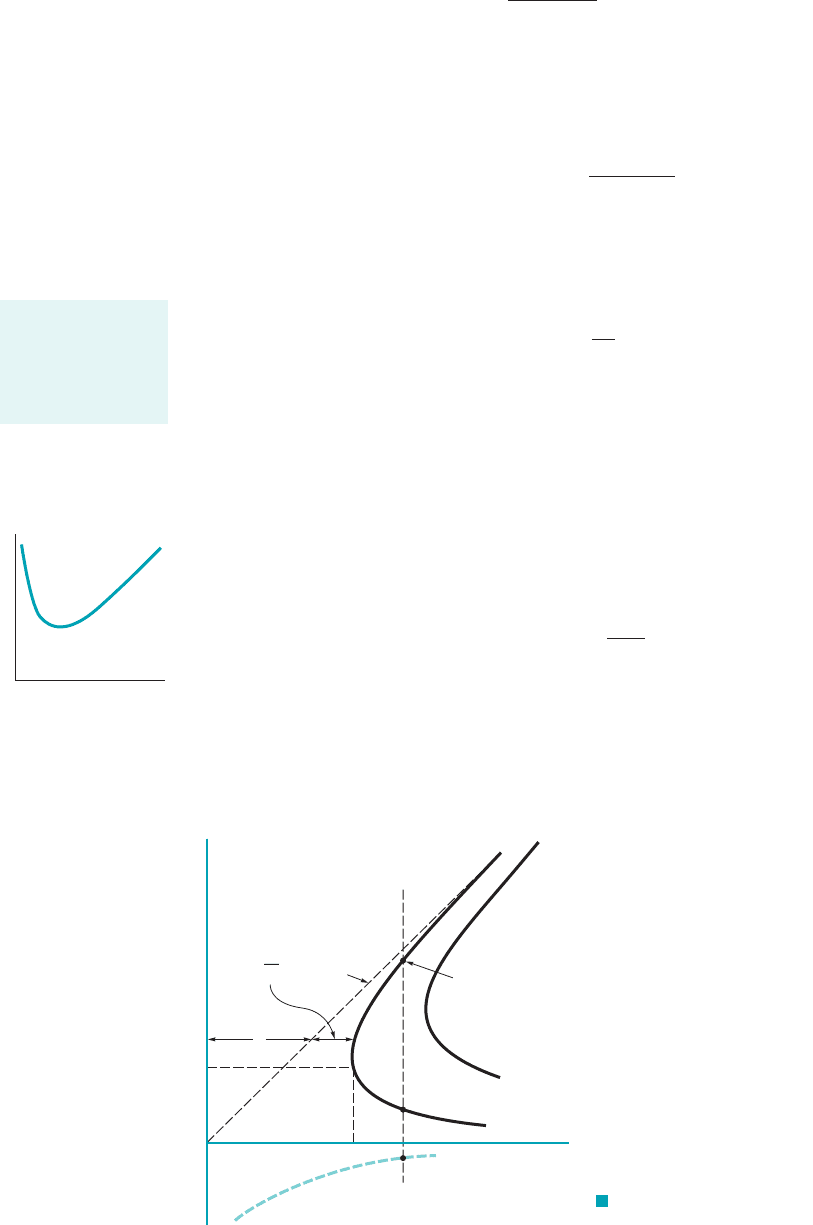
Chapter 3 that the energy line is located a distance z 1the elevation from some datum to the channel
bottom2plus the pressure head plus the velocity head above the datum. Therefore,
Eq. 10.6 can be written as
(10.7)
If there is no head loss, the energy line is horizontal and the total energy of the
flow is free to shift between kinetic energy and potential energy in a conservative fashion. In
the specific instance of a horizontal channel bottom and negligible head loss
Eq. 10.7 simply becomes
10.3.1 Specific Energy
The concept of the specific energy or specific head, E, defined as
(10.8)
is often useful in open-channel flow considerations. The energy equation, Eq. 10.7, can be written
in terms of E as
(10.9)
If head losses are negligible, then so that and the sum of the
specific energy and the elevation of the channel bottom remains constant 1i.e.,
a statement of the Bernoulli equation2.
If we consider a simple channel whose cross-sectional shape is a rectangle of width b, the
specific energy can be written in terms of the flowrate per unit width, as
(10.10)
which is illustrated by the figure in the margin.
For a given channel of constant width, the value of q remains constant along the channel, although
the depth, y, may vary. To gain insight into the flow processes involved, we consider the specific energy
diagram, a graph of , with q fixed, as shown in Fig. 10.7. The relationship between the flow
depth, y, and the velocity head, as given by Eq. 10.8 is indicated in the figure.V
2
2g,
E E1y2
E y
q
2
2gy
2
Vyb
b Vy,q Q
b
E
1
z
1
E
2
z
2
,
1S
f
S
0
2/ S
0
/ z
2
z
1
S
f
0
E
1
E
2
1S
f
S
0
2/
E y
V
2
2g
y
1
y
2
1V
2
2
V
2
1
2
2g
1S
f
02,1S
0
02
1S
f
02,
y
1
y
2
1V
2
2
V
2
1
2
2g
1S
f
S
0
2/
1V
2
2g21p
g2
542 Chapter 10 ■ Open-Channel Flow
The specific energy
is the sum of poten-
tial energy and
kinetic energy (per
unit weight).
E
y
q = constant
F I G U R E 10.7 Specific energy
diagram.
y = E
y
y
sub
y
sup
y
neg
y
c
E
min
E
q = q'
q
= q" > q
'
y
V
2
2g
JWCL068_ch10_534-578.qxd 9/23/08 11:51 AM Page 542

For given q and E, Eq. 10.10 is a cubic equation with three
solutions, and If the specific energy is large enough 1i.e., where is a
function of q2, two of the solutions are positive and the other, is negative. The negative root,
represented by the curved dashed line in Fig. 10.7, has no physical meaning and can be ignored.
Thus, for a given flowrate and specific energy there are two possible depths, unless the vertical
line from the E axis does not intersect the specific energy curve corresponding to the value of q
given 1i.e., 2. These two depths are termed alternate depths.
For large values of E the upper and lower branches of the specific energy diagram
approach and respectively. These limits correspond to a very deep channel flowing
very slowly as with fixed2, or a very high-speed flow in a
shallow channel
As is indicated in Fig. 10.7, Thus, since is constant along the curve, it
follows that where the subscripts “sub” and “sup” on the velocities correspond to the
depths so labeled. The specific energy diagram consists of two portions divided by the “nose”
of the curve. We will show that the flow conditions at this location correspond to critical conditions
those on the upper portion of the curve correspond to subcritical conditions 1hence, the
“sub” subscript2, and those on the lower portion of the curve correspond to supercritical conditions
1hence, the “sup” subscript2.
To determine the value of we use Eq. 10.10 and set to obtain
or
(10.11)
where the subscript “c” denotes conditions at By substituting this back into Eq. 10.10 we
obtain
By combining Eq. 10.11 and , we obtain
or Thus, critical conditions occur at the location of Since the
layer is deeper and the velocity smaller for the upper part of the specific energy diagram 1compared
with the conditions at 2, such flows are subcritical Conversely, flows for the lower
part of the diagram are supercritical. This is shown by the figure in the margin. Thus, for a given
flowrate, q, if there are two possible depths of flow, one subcritical and the other
supercritical.
It is often possible to determine various characteristics of a flow by considering the specific
energy diagram. Example 10.2 illustrates this for a situation in which the channel bottom eleva-
tion is not constant.
E 7 E
min
1Fr 6 12.E
min
E
min
.1Fr 12Fr
c
⬅ V
c
1gy
c
2
1
2
1.
V
c
q
y
c
1y
3
2
c
g
1
2
2
y
c
1gy
c
V
c
q
y
c
E
min
3y
c
2
E
min
.
y
c
a
q
2
g
b
1
3
dE
dy
1
q
2
gy
3
0
dE
dy 0E
min
,
1Fr 12,
E
min
V
sup
7 V
sub
,
q Vyy
sup
6 y
sub
.
1E y V
2
2g S V
2
2g as y S 02.
q Vyy S 1E y V
2
2g S y
y 0,y E
1y
sub
and y
sup
2
E 6 E
min
y
neg
,
E
min
E 7 E
min
,y
neg
.y
sup
, y
sub
,
3y
3
Ey
2
1q
2
2g2 04
10.3 Energy Considerations 543
For a given value
of specific energy, a
flow may have al-
ternate depths.
E
Fr = 1
Fr < 1
Fr > 1
y
GIVEN Water flows up a 0.5-ft-tall ramp in a constant width
rectangular channel at a rate as is shown in Fig.
E10.2a. 1For now disregard the “bump.”2The upstream depth is
2.3 ft and viscous effects are negligible.
q 5.75 ft
2
s
Specific Energy Diagram—Quantitative
E
XAMPLE 10.2
FIND Determine the elevation of the water surface downstream
of the ramp,
y
2
z
2
.
JWCL068_ch10_534-578.qxd 9/23/08 11:52 AM Page 543
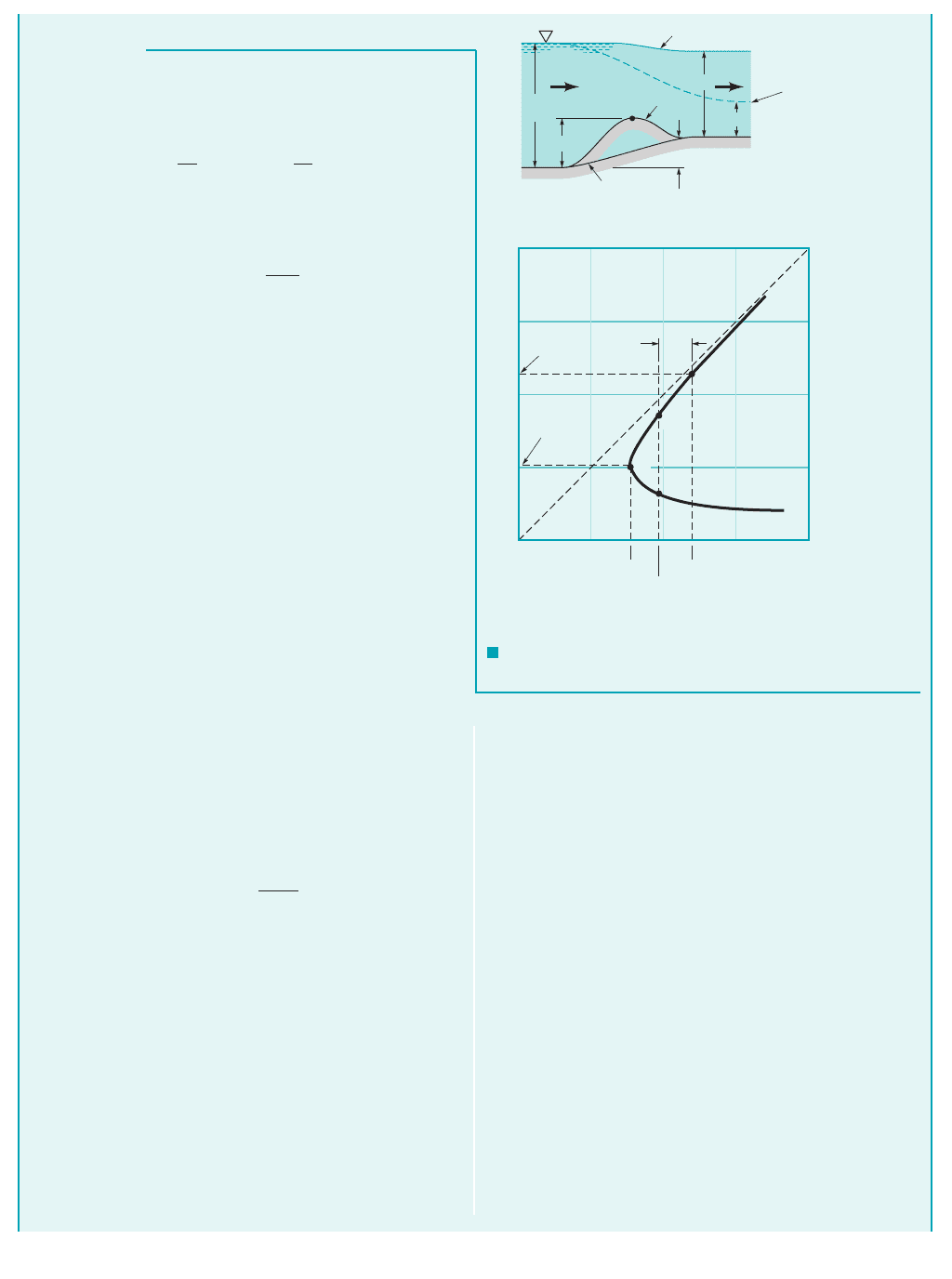
544 Chapter 10 ■ Open-Channel Flow
F I G U R E E10.2
(b)
0
0
1
2
3
4
1234
y, ft
(c)
(2')
(2)
0.5
(1)
E
min
= 1.51 E
1
= 2.40
E, ft
E
2
= 1.90
y
1
= 2.30
q =
5.75 ft
2
/s
y
c
=
1.01
S
OLUTION
specific energy to As is seen from Fig. E10.2a, this would
require a specified elevation 1bump2in the channel bottom so
that critical conditions would occur above this bump. The height
of this bump can be obtained from the energy equation 1Eq.
10.92written between points 112and 1c2with 1no viscous
effects2and . That is, . In par-
ticular, since and
the top of this bump would need to be
above the chan-
nel bottom at section 112. The flow could then accelerate to su-
percritical conditions as is shown by the free surface
represented by the dashed line in Fig. E10.2a.
Since the actual elevation change 1a ramp2shown in Fig.
E10.2a does not contain a bump, the downstream conditions will
correspond to the subcritical flow denoted by 122, not the super-
critical condition Without a bump on the channel bottom,
the state is inaccessible from the upstream condition state 112.
Such considerations are often termed the accessibility of flow
regimes. Thus, the surface elevation is
(Ans)
Note that since and the
elevation of the free surface decreases as it goes across the
ramp.
y
2
⫹ z
2
⫽ 2.22 ft,y
1
⫹ z
1
⫽ 2.30 ft
y
2
⫹ z
2
⫽ 2.22 ft
12¿2
12¿2.
1Fr
2¿
7 12
ft ⫺ 1.51 ft ⫽ 0.89 ftz
c
⫺ z
1
⫽ E
1
⫺ E
min
⫽ 2.40
31q
2
Ⲑ
g2
1
Ⲑ
3
Ⲑ
2 ⫽ 1.51 ft,
E
min
⫽ 3y
c
Ⲑ
2 ⫽
E
1
⫽ y
1
⫹ 0.513
Ⲑ
y
1
2
⫽ 2.40 ft
E
1
⫽ E
min
⫺ z
1
⫹ z
c
S
0
/ ⫽ z
1
⫺ z
c
S
f
⫽ 0
E
min
.
With and conservation of energy 1Eq. 10.6
which, under these conditions, is actually the Bernoulli equation2
requires that
For the conditions given and
this becomes
(1)
where and are in ft兾s and feet, respectively. The continuity
equation provides the second equation
or
(2)
Equations 1 and 2 can be combined to give
which has solutions
Note that two of these solutions are physically realistic, but the
negative solution is meaningless. This is consistent with the previ-
ous discussions concerning the specific energy 1recall the three
roots indicated in Fig. 10.72. The corresponding elevations of the
free surface are either
or
The question is which of these two flows is to be expected? This
can be answered by use of the specific energy diagram obtained
from Eq. 10.10, which for this problem is
where E and y are in feet. The diagram is shown in Fig. E10.2b.
The upstream condition corresponds to subcritical flow; the
downstream condition is either subcritical or supercritical,
corresponding to points 2 or Note that since
it follows that the downstream condi-
tions are located 0.5 ft to the left of the upstream conditions on the
diagram.
With a constant width channel, the value of q remains the
same for any location along the channel. That is, all points for
the flow from 112to 122or must lie along the
curve shown. Any deviation from this curve would imply either
a change in q or a relaxation of the one-dimensional flow as-
sumption. To stay on the curve and go from 112around the criti-
cal point 1point c2to point would require a reduction in 12¿2
q ⫽ 5.75 ft
2
Ⲑ
s
12¿2
1z
2
⫺ z
1
2⫽ E
2
⫹ 0.5 ft,
E
1
⫽ E
2
⫹2¿.
E ⫽ y ⫹
0.513
y
2
y
2
⫹ z
2
⫽ 0.638 ft ⫹ 0.50 ft ⫽ 1.14 ft
y
2
⫹ z
2
⫽ 1.72 ft ⫹ 0.50 ft ⫽ 2.22 ft
y
2
⫽ 1.72 ft,
y
2
⫽ 0.638 ft,
or
y
2
⫽⫺0.466 ft
y
2
3
⫺ 1.90y
2
2
⫹ 0.513 ⫽ 0
y
2
V
2
⫽ 5.75 ft
2
Ⲑ
s
y
2
V
2
⫽ y
1
V
1
y
2
V
2
1.90 ⫽ y
2
⫹
V
2
2
64.4
V
1
⫽ q
Ⲑ
y
1
⫽ 2.5 ft
Ⲑ
s2,
y
1
⫽ 2.3 ft,1z
1
⫽ 0, z
2
⫽ 0.5 ft,
y
1
⫹
V
2
1
2g
⫹ z
1
⫽ y
2
⫹
V
2
2
2g
⫹ z
2
h
L
⫽ 0,S
0
/ ⫽ z
1
⫺ z
2
y
1
=
2.3 ft
V
1
=
2.5 ft/s
V
2
y
2
z
1
= 0
z
2
= 0.5 ft
0.89 ft
0.5 ft
Ramp
Bump
Free surface with ramp
Free
surface
with bump
(
a)
(
c)
y
2
JWCL068_ch10_534-578.qxd 9/30/08 3:45 PM Page 544
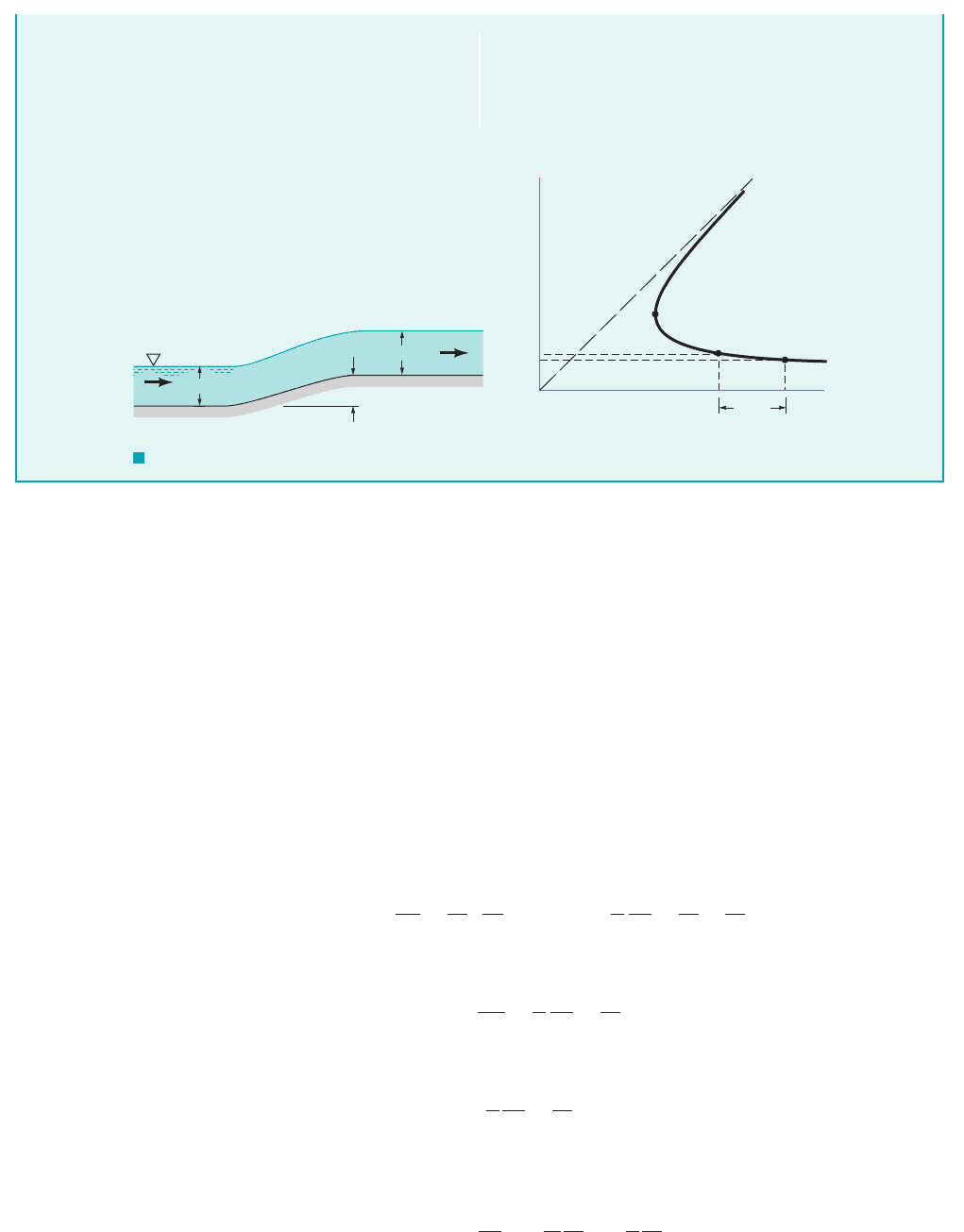
10.3.2 Channel Depth Variations
By using the concepts of the specific energy and critical flow conditions it is possible to
determine how the depth of a flow in an open channel changes with distance along the channel.
In some situations the depth change is very rapid so that the value of is of the order of 1.
Complex effects involving two- or three-dimensional flow phenomena are often involved in such
flows.
In this section we consider only gradually varying flows. For such flows, and it
is reasonable to impose the one-dimensional velocity assumption. At any section the total head is
and the energy equation 1Eq. 10.52becomes
where is the head loss between sections 112and 122.
As is discussed in the previous section, the slope of the energy line is and
the slope of the channel bottom is Thus, since
we obtain
or
(10.12)
For a given flowrate per unit width, q, in a rectangular channel of constant width b, we have
or by differentiation
dV
dx
q
y
2
dy
dx
V
y
dy
dx
V q
y
V
g
dV
dx
dy
dx
S
f
S
0
dh
L
dx
V
g
dV
dx
dy
dx
S
0
dH
dx
d
dx
a
V
2
2g
y zb
V
g
dV
dx
dy
dx
dz
dx
dz
dx S
0
.
dH
dx dh
L
dx S
f
h
L
H
1
H
2
h
L
H V
2
2g y z
dy
dx 1
dy
dx
1Fr 12,
10.3 Energy Considerations 545
112on the lower 1supercritical2branch of the specific energy curve
and ends at 122on the same branch with Since both y and
z increase from 112to 122, the surface elevation, also
increases. Thus, flow up a ramp is different for subcritical than it
is for supercritical conditions.
y z,
y
2
7 y
1
.
COMMENT If the flow conditions upstream of the ramp
were supercritical, the free-surface elevation and fluid depth
would increase as the fluid flows up the ramp. This is indicated in
Fig. E10.2c along with the corresponding specific energy dia-
gram, as is shown in Fig. E10.2d. For this case the flow starts at
F I G U R E E10.2 (
Continued
)
(2)
0.5 ft
(1)
E
y
y
2
y
1
(d)(c)
V
1
> c
1
V
2
> c
2
y
1
y
2
> y
1
0.5 ft
JWCL068_ch10_534-578.qxd 9/23/08 11:52 AM Page 545

so that the kinetic energy term in Eq. 10.12 becomes
(10.13)
where is the local Froude number of the flow. Substituting Eq. 10.13 into Eq. 10.12
and simplifying gives
(10.14)
It is seen that the rate of change of fluid depth, depends on the local slope of the
channel bottom, , the slope of the energy line, , and the Froude number, Fr. As shown by the
figure in the margin, the value of can be either negative, zero, or positive, depending on
the values of these three parameters. That is, the channel flow depth may be constant or it may
increase or decrease in the flow direction, depending on the values of , , and Fr. The behavior
of subcritical flow may be the opposite of that for supercritical flow, as seen by the denominator,
of Eq. 10.14.
Although in the derivation of Eq. 10.14 we assumed q is constant 1i.e., a rectangular channel2,
Eq. 10.14 is valid for channels of any constant cross-sectional shape, provided the Froude number
is interpreted properly 1Ref. 32. In this book we will consider only rectangular cross-sectional
channels when using this equation.
1 ⫺ Fr
2
,
S
f
S
0
dy
Ⲑ
dx
S
f
S
0
dy
Ⲑ
dx,
dy
dx
⫽
1S
f
⫺ S
0
2
11 ⫺ Fr
2
2
Fr ⫽ V
Ⲑ
1gy2
1
Ⲑ
2
V
g
dV
dx
⫽⫺
V
2
gy
dy
dx
⫽⫺Fr
2
dy
dx
546 Chapter 10 ■ Open-Channel Flow
10.4 Uniform Depth Channel Flow
Many channels are designed to carry fluid at a uniform depth all along their length. Irrigation canals
are frequently of uniform depth and cross section for considerable lengths. Natural channels such
as rivers and creeks are seldom of uniform shape, although a reasonable approximation to the
flowrate in such channels can often be obtained by assuming uniform flow. In this section we will
discuss various aspects of such flows.
Uniform depth flow can be accomplished by adjusting the bottom slope, so
that it precisely equals the slope of the energy line, That is, This can be seen from Eq.
10.14. From an energy point of view, uniform depth flow is achieved by a balance between the
potential energy lost by the fluid as it coasts downhill and the energy that is dissipated by viscous
effects 1head loss2associated with shear stresses throughout the fluid. Similar conclusions can be
reached from a force balance analysis as discussed in the following section.
10.4.1 Uniform Flow Approximations
We consider fluid flowing in an open channel of constant cross-sectional size and shape such that
the depth of flow remains constant as is indicated in Fig. 10.8. The area of the section is A and
the wetted perimeter 1i.e., the length of the perimeter of the cross section in contact with the fluid2
is P. The interaction between the fluid and the atmosphere at the free surface is assumed negligible
so that this portion of the perimeter is not included in the definition of the wetted perimeter.
Since the fluid must adhere to the solid surfaces, the actual velocity distribution in an open
channel is not uniform. Some typical velocity profiles measured in channels of various shapes are
indicated in Fig. 10.9a. The maximum velocity is often found somewhat below the free surface,
S
0
⫽ S
f
.S
f
.
S
0
,1dy
Ⲑ
dx ⫽ 02
V10.6 Merging
channels
0
0.5 1.5 2
Fr
dy
dx
S
f
= S
o
S
f
> S
o
S
f
< S
o
F I G U R E 10.8
Uniform flow in an open channel.
Q
a
a
Free surface A = flow area
P = wetted
perimeter
Section –
aa
(a)(b)
The wall shear
stress acts on the
wetted perimeter
of the channel.
JWCL068_ch10_534-578.qxd 9/23/08 11:52 AM Page 546
